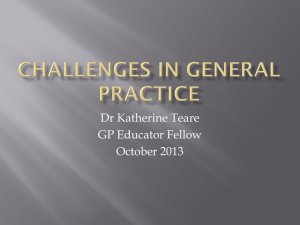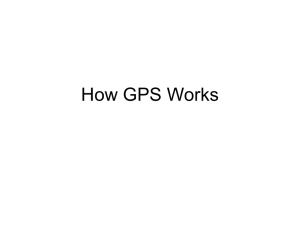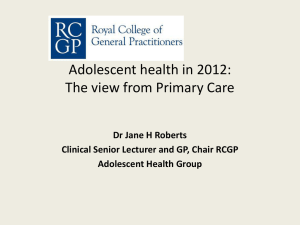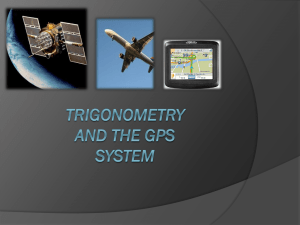receiver
advertisement
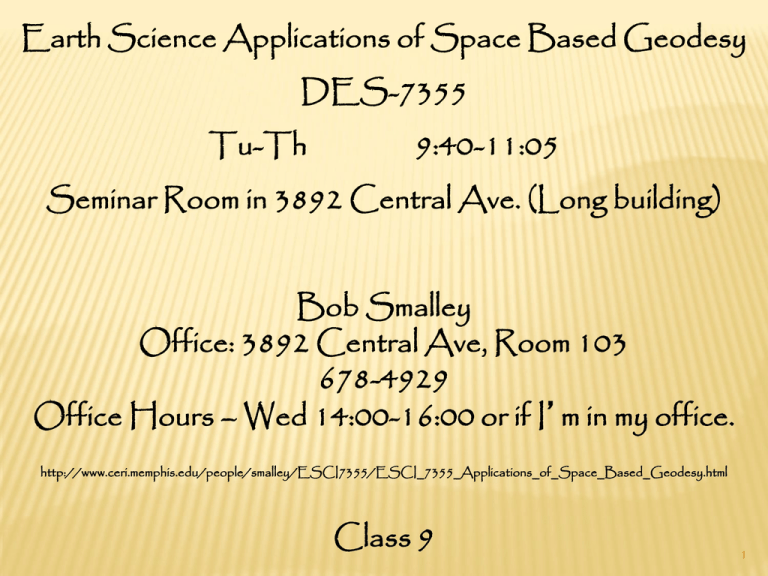
Earth Science Applications of Space Based Geodesy
DES-7355
Tu-Th
9:40-11:05
Seminar Room in 3892 Central Ave. (Long building)
Bob Smalley
Office: 3892 Central Ave, Room 103
678-4929
Office Hours – Wed 14:00-16:00 or if I’m in my office.
http://www.ceri.memphis.edu/people/smalley/ESCI7355/ESCI_7355_Applications_of_Space_Based_Geodesy.html
Class 9
1
When two sound waves of different frequency approach
your ear, the alternating constructive and destructive
interference causes the sound to be alternatively soft and
loud
-a phenomenon which is called "beating" or producing beats.
-The beat frequency is equal to the absolute value of the
difference in frequency of the two waves.
http://hyperphysics.phy-astr.gsu.edu/hbase/sound/beat.html
2
Beat Frequencies in Sound
The sound of a beat frequency or beat wave is a fluctuating
volume caused when you add two sound waves of slightly
different frequencies together.
If the frequencies of the sound waves are close enough
together, you can hear a relatively slow variation in the
volume of the sound.
A good example of this can be heard using two tuning forks
that are a few Hz apart. (or in a twin engine airplane or boat
when the engines are not “synched” = you hear a “wa-wawa-wa-… noise)
http://www.school-for-champions.com/science/sound_beat.htm
3
Beats are caused by the interference of two waves at the
same point in space.
æ f1 - f 2 ö æ f1 + f 2 ö
cos(2pf1) + cos(2pf 2 ) = 2Acosç2p
÷ cosç2p
÷
è
2 ø è
2 ø
fbeat = f1 - f2
Beat -- Frequency of
minimia, which
happens twice per
cycle.
http://hyperphysics.phy-astr.gsu.edu/hbase/sound/beat.html
4
Note the frequencies are
half the difference and
the average of the original frequencies.
æ f1 - f 2 ö æ f1 + f 2 ö
cos(2pf1) + cos(2pf 2 ) = 2Acosç2p
÷ cosç2p
÷
è
2 ø è
2 ø
"Different" than
multiplying (mixing)
the two frequencies.
(but be careful since sum on LHS is equal to
product on RHS)
http://hyperphysics.phy-astr.gsu.edu/hbase/sound/beat.html
5
What if we look at it in the frequency domain –
Adding in TD and FD is linear.
So we get same two spikes we would have gotten if we had
looked at each separately.
æ f1 - f 2 ö æ f1 + f 2 ö
cos(2pf1) + cos(2pf 2 ) = 2Acosç2p
÷ cosç2p
÷
è
2 ø è
2 ø
http://hyperphysics.phy-astr.gsu.edu/hbase/sound/beat.html
6
What if we take the product (multiply, or mix) – i.e. start on
the RHS of the last analysis.
(get sum and difference of components, not half)
cos ( 2p f1 ) *cos ( 2p f2 ) =
http://hyperphysics.phy-astr.gsu.edu/hbase/sound/beat.html
Acos ( 2p ( f1 - f2 )) + cos ( 2p ( f1 + f2 ))
2
7
Product (multiply, or
mix)
Compare FT of
product to those of
components and sum.
http://hyperphysics.phy-astr.gsu.edu/hbase/sound/beat.html
8
In terms of our GPS signals we get
(we are now mixing – multiplying, not adding.
G= GPS signal, R= Reference signal.)
R( t ) Ä G( t ) = G0 sin(2pfG ( t )) ´ R0 sin(2pf R ( t ))
( (
) (
G0 R0
R( t ) Ä G( t ) =
cos 2p (f R ( t ) - fG ( t )) cos 2p (fR ( t ) + fG ( t ))
2
))
Note this is in terms of phase, f(t), not frequency
(“usual” presentation; wt, produces phase)
Blewitt, Basics of GPS in “Geodetic Applications of GPS”
9
“Filter” to remove high frequency part
(f ( t) + f (t ))
R
G
leaving beat signal
(
G0 R0
B( t ) =
cos 2p (f R ( t ) - fG ( t ))
2
G0 R0
B( t ) =
cos(2pf B ( t ))
2
Blewitt, Basics of GPS in “Geodetic Applications of GPS”
)
10
if you differentiate fB
you find the
beat frequency
the difference between the two frequencies
(actually one wants to take the absolute value)
– as we found before
dfB ( t ) df R ( t ) dfG ( t )
=
dt
dt
dt
f B = f R - fG
Blewitt, Basics of GPS in “Geodetic Applications of GPS”
11
If the receiver copy of the signal has the same code applied
as the satellite signal This discussion continues to hold (the -1’s cancel)
(one might also worry about the Doppler shift effect on the
codes, but this effect is second order)
If the receiver copy of the signal does not have the code
applied (e.g. – we don’t know the P code)
then this discussion will not work (at least not simply)
Blewitt, Basics of GPS in “Geodetic Applications of GPS”
12
There are essentially two means by which the carrier wave
can be recovered from the incoming modulated signal:
Reconstruct the carrier wave by removing the ranging code
and broadcast message modulations.
Squaring, or otherwise processing the received signal
without using a knowledge of the ranging codes.
http://www.gmat.unsw.edu.au/snap/gps/gps_survey/chap3/323.htm
13
To reconstruct the signal, the ranging codes (C/A and/or
P code)
must be known.
The extraction of the Navigation Message can then be
easily performed by reversing the process by which the biphase shift key modulation was carried out in the satellite.
http://www.gmat.unsw.edu.au/snap/gps/gps_survey/chap3/323.htm
14
In the squaring method no knowledge of the ranging codes
is required.
The squaring removes the effects of the -1’s
(but halves the wavelength and makes the signal noisier)
More complex signal processing is required to make carrier
phase measurements on the L2 signal under conditions of
Anti-Spoofing (don’t know P-code).
http://www.gmat.unsw.edu.au/snap/gps/gps_survey/chap3/323.htm
15
As mentioned earlier:
can arbitrarily add N(2p) to phase
and get same beat signal
This is because we have no direct measure of the “total”
(beat) phase
F+ N = fR - fG
(argument is 2pf, so no 2p here)
Blewitt, Basics of GPS in “Geodetic Applications of GPS”
16
F+ N = fR - fG
GPS receiver records F
total number of (beat) cycles since lock on satellite
N is fixed (as long as lock on satellite is maintained)
N is called the “ambiguity” (or “integer ambiguity”)
It is an integer (theoretically)
If loose lock – cycle slip, have to estimate new N.
Blewitt, Basics of GPS in “Geodetic Applications of GPS”
17
Making a few reasonable assumptions we can interpret N
geometrically to be the number of carrier wavelengths
between the receiver (when it makes the first observation)
and the satellite (when it transmitted the signal)
Blewitt, Basics of GPS in “Geodetic Applications of GPS”
18
From E. Calais
How to use (beat) phase to measure distance?
phase -> clock time -> distance
19
Phase to velocity and position
Consider a fixed transmitter and a fixed
receiver
Receiver sees constant rate of change of
phase (fixed frequency) equal to that of the
transmitter
Integrated phase increases linearly with
time
http://www.npwrc.usgs.gov/perm/cranemov/location.htm
http://electron9.phys.utk.edu/phys135d/modules/m10/doppler.htm
20
Next consider a transmitter moving on a line through a fixed
receiver
Receiver again sees a constant rate of change of phase
(frequency) – but it is no longer equal to that of the
transmitter
F( t) = f¢t + ( N)
See lower
frequency when
XTR moving
away
http://electron9.phys.utk.edu/phys135d/modules/m10/doppler.htm
See higher
frequency when
XTR moving
towards
21
The change in the rate of phase change (fixed change in
frequency) observed at receiver, with respect to stationary
transmitter, is proportional to velocity of moving transmitter.
f0
f ( x,t ) = f 0 - v
c
c is speed of
waves in medium,
v is velocity of
transmitter
http://electron9.phys.utk.edu/phys135d/modules/m10/doppler.htm
(this is classical,
not relativistic)
22
If you knew the frequency transmitted by the moving
transmitter.
You can use the
beat frequency
produced by combining the received signal with a receiver
generated signal that is at the transmitted frequency
to determine the speed.
http://electron9.phys.utk.edu/phys135d/modules/m10/doppler.htm
23
But we can do more.
We can
count the (beat) cycles
or measure the (beat) phase
of the beat signal as a function of time.
This will give us the change in distance.
(as will velocity times time)
Blewitt, Basics of GPS in “Geodetic Applications of GPS”
24
So we can write
Beat phase ( t ) = change in distance to transmitter +
constant
Beat phase ( at t = tfixed ) = distance to transmitter +
constant
Note the arbitrary constant –
can redo measurements from another position
(along trajectory of moving transmitter)
and get same result
(initial phase measurement will be different, but that will not
change the frequency or distance estimation)
Blewitt, Basics of GPS in “Geodetic Applications of GPS”
25
Next – move the receiver off the path of the transmitter
(and can also let the transmitter path be arbitrary, now have
to deal with vectors.)
f0
f ( x,t ) = f 0 - v ( t ) · u( t )
c
www.ws.binghamton.edu/fowler/fowler personal page/ EE522_files/CRLB for Dopp_Loc Notes.pdf
http://www.cls.fr/html/argos/general/doppler_gps_en.html
26
Can solve this for
Location of stationary transmitter from a moving receiver (if
you know x and v of receiver – how SARSAT, ELT,
EPIRB’s [Emergency Position Indicating Radio
Beacon's ] work [or used to work – now also transmit location from GPS])
Location of moving transmitter
(solve for x and v of transmitter)
from a stationary receiver
(if you know x of receiver)
(Doppler shift, change in frequency, more useful for
estimating velocity than position.
Integrate Doppler phase to get position.)
27
http://www.npwrc.usgs.gov/perm/cranemov/location.htm
28
Apply this to GPS
So far we have
Satellite carrier signal
Mixed with copy in receiver
After “low pass filter” – left with beat signal
Phase of beat signal equals reference phase minus received
phase plus unknown integer number full cycles
From here on we will follow convention and call
- Carrier beat phase -Carrier phase –
(remember it is NOT the phase of the incoming signal)
Blewitt, Basics of GPS in “Geodetic Applications of GPS”
29
Consider the observation of satellite S
We can write the observed carrier (beat) phase as
F (T) = f(T) - f (T) - N
S
S
S
Receiver replica of signal
Incoming signal received from satellite S
Receiver clock time
Blewitt, Basics of GPS in “Geodetic Applications of GPS”
30
Now assume that the phase from the satellite received at
time T is equal to what it was when it was transmitted from
the satellite
(we will eventually need to be able to model the travel time)
S
S
S
S
S
f S ( x, y, z,T ) = ftransmit
x
,
y
,
z
,T
(
transmit )
Blewitt, Basics of GPS in “Geodetic Applications of GPS”
31
S
S
S
FS (T ) = f (T ) - ftransmit
T
N
( transmit )
f( t) - f )
(
T( t) =
Use from before for receiver time
0
f0
f ( T ) = f0 T + f 0
f
S
transmit
(T
S
transmit
)= f T
S
0 transmit
+f
S
0
So the carrier phase observable becomes
S
FS (T ) = f 0T + f 0 - f 0Ttransmit
- f 0S - N S
S
S
S
FS (T ) = f 0 (T - Ttransmit
+
f
f
N
) 0 0
Blewitt, Basics of GPS in “Geodetic Applications of GPS”
32
F (T ) = f 0 (T - T
S
S
transmit
)+f
0
-f -N
S
0
S
Terms with S are for each satellite
All other terms are equal for all observed satellites
(receiver f0 should be same for all satellites– no interchannel
bias, and receiver should sample all satellites at same time –
or interpolate measurements to same time)
T S and N S will be different for each satellite
Last three terms cannot be separated (and will not be an
integer) – call them “carrier phase bias”
Blewitt, Basics of GPS in “Geodetic Applications of GPS”
33
Now we will convert carrier phase to range
(and let the superscript S-> satellite number, j,
to handle more than one satellite, and
add a subscript for multiple receivers, A,
to handle more than one receiver.)
F (TA ) = f0 (TA,received -T
j
A
Blewitt, Basics of GPS in “Geodetic Applications of GPS”
j,transmited
j
+
f
f
N
) ( 0 )A ( 0 ) A
j
34
We will also drop the “received” and “transmitted”
reminders.
Times with superscripts will be for the transmission time by
the satellite.
Times with subscripts will be for the reception time by the
receiver.
F (TA ) = f0 ( TA -T ) + f0 A - f - N
j
A
Blewitt, Basics of GPS in “Geodetic Applications of GPS”
j
j
0
j
A
35
If we are using multiple receivers, they should all sample at
exactly the same time
(same value for receiver clock time).
Values of clock times of sample – epoch.
With multiple receivers the clocks are not perfectly
synchronized, so the true measurement times will vary
slightly.
Also note – each receiver-satellite pair has its own carrier
phase ambiguity.
Blewitt, Basics of GPS in “Geodetic Applications of GPS”
36
Aside
Synchronizing clocks brings up
Relativity
GPS
24 satellites in 6 orbital planes.
Carry highly stable atomic clocks
to generate GPS signals (GPS
really measures time, not
distance)
Measure distance (really time
of flight, and use speed of light
to get distance) to each
satellite in view and use
trilateration (not triangulation)
to determine position.
GPS and Relativity
Measurement of time in
different places (4+ satellites
and receiver) brings up question
of simultaneity.
This brings in special relativity.
Variation of gravity between
surface of earth and orbits
brings in general relativity.
Special and General Theories of Relativity
- Special relativity
Published 1905
kinematics, mechanics, and electromagnetism
- General relativity
Published 1915
gravitation
(includes special relativity)
Relativistic effects must be considered when i) measuring
time with moving clocks and b) in the propagation of
electromagnetic signals.
After: Robert A. Nelson, Satellite Engineering Research Corporation, Bethesda, MD
Relativistic Effects
Three (this number varies with author) effects
- Velocity (time dilation)
Moving (satellite) clock runs slow
Function of speed only
- Gravitational potential (red shift)
clock in lower G (satellite) runs faster
Function of altitude only
- Sagnac effect (can be classical or relativistic
Interferometry (synch rotating system of clocks)
Depends on direction and path traveled
After: Robert A. Nelson, Satellite Engineering Research Corporation, Bethesda, MD, and N. Ashby U. Colorado
- Gravitational redshift (blueshift)
Orbital altitude 20,183 km
Clock runs fast by 45.7 s per day
- Time dilation
Satellite velocity 3.874 km/s
Clock runs slow by 7.1 s per day
Net secular effect (satellite clock runs fast)
Clock runs fast by 38.6 s per day
- Residual periodic effect
Orbital eccentricity 0.02
Amplitude of periodic effect 46 ns
- Sagnac effect
Maximum value 133 ns for a stationary receiver on the earth
After: Robert A. Nelson, Satellite Engineering Research Corporation, Bethesda, MD, and N. Ashby U. Colorado
Net secular relativistic effect is 38.6 s per day
- Nominal clock rate is 10.23 MHz
Satellite clocks are offset by – 4.464733 parts in
1010 to compensate effect
- Resulting (proper) frequency in orbit is
10229999.9954326 Hz
- Observed (on earth) average rate of satellite
clock is same as clock on earth.
After: Robert A. Nelson, Satellite Engineering Research Corporation, Bethesda, MD, and N. Ashby U. Colorado
- Residual periodic effect
Maximum amplitude 46 ns
Correction applied in receiver
- Sagnac effect
Maximum value 133 ns
Correction applied in receiver
After: Robert A. Nelson, Satellite Engineering Research Corporation, Bethesda, MD, and N. Ashby U. Colorado
Return to carrier phase processing
carrier phase to range
Multiply phase (in cycles, not radians) by wavelength to get
“distance”
LAj (TA ) is in units of meters
BAj is “carrier phase bias” (in meters)
(is not an integer)
Blewitt, Basics of GPS in “Geodetic Applications of GPS”
46
a distance
This equation looks exactly like the equation for pseudorange
That we saw before
Blewitt, Basics of GPS in “Geodetic Applications of GPS”
47
pseudo-range
constant
This equation also holds for both
L1 and L2
Clock biases same for L1 and L2, but ambiguity values
different (different wavelengths).
Blewitt, Basics of GPS in “Geodetic Applications of GPS”
48
Now that we have things expressed as “distance” (range)
Follow pseudo range development
Added a few things related to propagation of waves
Delay in signal due to
Troposphere – Z Aj
Ionosphere – -I j
A
(ionospheric term has “-” since phase velocity increases)
Blewitt, Basics of GPS in “Geodetic Applications of GPS”
49
Can include these effects in pseudo range development also
Delay in signal due to
Troposphere + Z Aj
Ionosphere + -IAj
(ionospheric term now has “+” since group velocity to first
order is same magnitude but opposite sign as phase
velocity)
50
Blewitt, Basics of GPS in “Geodetic Applications of GPS”
Another aside
http://webphysics.ph.msstate.edu/jc/library/1511/index.html
Set up to see phase vel and group vel opposite sign
(package goes one way, waves inside go other)
l = 24 and 22, v = 5 and 3 respectively
http://www.geneseo.edu/~freeman/animations/phase_ve
rsus_group_velocity.htm
51
One thing to keep in mind about the
phase velocity
is that it is an entirely mathematical construct.
Pure sine waves do not exist,
as a monochromatic wave train is infinitely long.
They are merely a tool to construct wave packets,
which have a group velocity,
and that is what we are measuring in experiments.
http://www.everything2.com: Source: R. U. Sexl and H. K. Urbantke, Relativität, Gruppen, Teilchen, chap. 2, 24, 3rd edn., Springer, Wien (1992)
52
In fact, it may very well be that the phase velocity comes out
higher than c,
(e.g. in wave guides!)
This puzzles people, and some use that fact to claim that the
theory of relativity is wrong.
However, even if you had a pure sine wave, you couldn't use
it to transmit any information,
because it is unmodulated,
so there is no contradiction.
http://www.everything2.com: Source: R. U. Sexl and H. K. Urbantke, Relativität, Gruppen, Teilchen, chap. 2, 24, 3rd edn., Springer, Wien (1992)
53
But it turns out that
even the group velocity may be higher than c,
namely in the case of anomalous dispersion
http://www.everything2.com: Source: R. U. Sexl and H. K. Urbantke, Relativität, Gruppen, Teilchen, chap. 2, 24, 3rd edn., Springer, Wien (1992)
54
Now how do we get around this?
Well, this kind of dispersion is so bad that the definition of
our wave packet loses its meaning because it just
disintegrates, and again we cannot use it to transmit
information.
The only way would be to switch the signal on and off these discontinuities propagate with the wavefront velocity
vF=lim k→∞(ω(k)/k)
And again, relativity is saved!
http://www.everything2.com: Source: R. U. Sexl and H. K. Urbantke, Relativität, Gruppen, Teilchen, chap. 2, 24, 3rd edn., Springer, Wien (1992), or
http://en.wikipedia.org/wiki/Faster-than-light
55
Back to phase processing
56
Now we have to fix the time
So far our expression has receiver and satellite clock time
-Not true time
Remember that the true time is the clock time adjusted by the
clock bias
t A TA A
Blewitt, Basics of GPS in “Geodetic Applications of GPS”
57
We know TA exactly
(it is the receiver clock time which is written into the
observation file – called a “time tag”)
t A TA A
But we don’t know A
(we need it to an accuracy of 1 sec)
Blewitt, Basics of GPS in “Geodetic Applications of GPS”
58
How to estimate A
- Use estimate of A from pseudo range point positioning
(if have receiver that uses the codes)
- LS iteration of code and phase data simultaneously
- If know satellite position and receiver location well enough
(300 m for receiver – 1 sec of distance) can estimate it
(this is how GPS is used for time transfer, once initialized
can get time with only one satellite visible [if don’t loose lock])
- Modeling shortcut – linearize (Taylor series)
Blewitt, Basics of GPS in “Geodetic Applications of GPS”
59
Big trick
Eliminating clock biases using differencing
60
Return to our model for the phase observable
clock error - receiver
clock error - satellite
What do we get if we combine
measurements made by two
receivers at the same epoch?
Blewitt, Basics of GPS in “Geodetic Applications of GPS”
61
Define the single difference
Use triangle to remember is
difference between satellite
(top) and two receivers (bottom)
Blewitt, Basics of GPS in “Geodetic Applications of GPS”
62
Satellite time errors cancel
(assume transmission times are same – probably not unless
range to both receivers from satellite the same)
If the two receivers are close together the tropospheric and
ionospheric terms also (approximately) cancel.
Blewitt, Basics of GPS in “Geodetic Applications of GPS”
63
How about we do this trick again
This time using two single differences to two satellites
(all at same epoch)
Define the double difference
Use inverted triangle to remember
is difference between two
satellites (top) and one receiver
(bottom)
Blewitt, Basics of GPS in “Geodetic Applications of GPS”
64
Now we have gotten rid of the receiver clock bias terms
(again to first order – and results better for short baselines)
Double differencing
- removes (large) clock bias errors
-approximately doubles (smaller) random errors due to
atmosphere, ionosphere, etc. (no free lunch)
- have to see both satellites from both receivers.
Blewitt, Basics of GPS in “Geodetic Applications of GPS”
65
Next – what is the ambiguity term after double difference
(remembering definition of B j )
A
The ambiguity term reduces to an integer
Blewitt, Basics of GPS in “Geodetic Applications of GPS”
66
So our final
Double difference observation
is
One can do the differencing in either order
The sign on the ambiguity term is arbitrary
Blewitt, Basics of GPS in “Geodetic Applications of GPS”
67
We seem to be on a roll here, so let’s do it again.
This time
(take the difference of double differences)
between two epochs
Equal if no
loss of lock
(no cycle
slip)
Blewitt, Basics of GPS in “Geodetic Applications of GPS”
From E. Calais
68
So now we have gotten rid of the integer ambiguity
If no cycle slip – ambiguities
removed.
If there is a cycle slip – get a
spike in the triple
difference.
Blewitt, Basics of GPS in “Geodetic Applications of GPS”
69
Raw Data from RINEX file: RANGE
Plot of C1 (range in meters)
For all satellites for full day of data
From Ben Brooks
70
Raw Data from RINEX file: RANGE
Plot of P1 (range in meters)
For one satellite for full day of data
From Ben Brooks
71
Raw Data from RINEX file: PHASE
From Ben Brooks
72
Raw Data from RINEX file: RANGE
DIFFERENCE
From Ben Brooks
73
Raw Data from RINEX file: PHASE
DIFFERENCE
From Ben Brooks
74
Zoom in on phase observable
Without an (L1) and with an (L2) cycle slip
8000000
L1_phase
Phase (cycles)
6000000
L2_phase
4000000
2000000
Cycle slip at L2
0
-2000000
18. 8
http://www-gpsg.mit.edu/~tah/12.540/
19. 0
19. 2
Hrs
19. 4
19. 6
19. 8
75
Cycle slip shows up as spike in triple difference
(so can identify and fix)
Have to do this for “all” pairs of receiver-satellite pairs.
http://www.gmat.unsw.edu.au/snap/gps/gps_survey/chap7/735.htm
76
Effects of triple differences on estimation
Further increase in noise
Additional effect – introduces
correlation between observations in time
This effect substantial
So triple differences limited to identifying and fixing cycle
slips.
77
Using double difference phase observations for relative
positioning
First notice that if we make all double differences - even
ignoring the obvious duplications
We get a lot more double differences than original data.
This can’t be (can’t create information).
Blewitt, Basics of GPS in “Geodetic Applications of GPS”
78
Consider the case of 3 satellites observed by 2 receivers.
Form the (non trivial)
double differences
jk
LAB
= ( LAj - LBj ) - ( LkA - LkB )
L
jl
AB
= (L - L
j
A
j
B
LlkAB = ( LlA - LlB
) - (L
) - (L
l
A
-L
k
A
- LkB
l
B
)
)
Note that we can form any one from
a linear combination of the other two
(linearly dependent)
jk
jl
LAB
= LAB
- LlkAB
jl
AB
L
=L
jk
AB
-L
lk
AB
jk
jl
LlkAB = LAB
- LAB
We need a linearly independent set for Least Squares.
Blewitt, Basics of GPS in “Geodetic Applications of GPS”
79
From the linearly dependent set
jk
jl
lk
L
,L
,L
{ AB AB AB }
We can form a number of linearly independent subsets
{L
{L
{L
jk
AB
jl
AB
,L
kj
AB
,LklAB
lj
AB
lk
AB
,L
j
ab
AB
} = L = {L
} = L = {L
} = L = {L
a = j;b ¹ j}
k
ab
AB
a = k;b ¹ k}
l
ab
AB
a = l;b ¹ l}
Which we can then use for our Least Squares estimation.
Blewitt, Basics of GPS in “Geodetic Applications of GPS”
80



